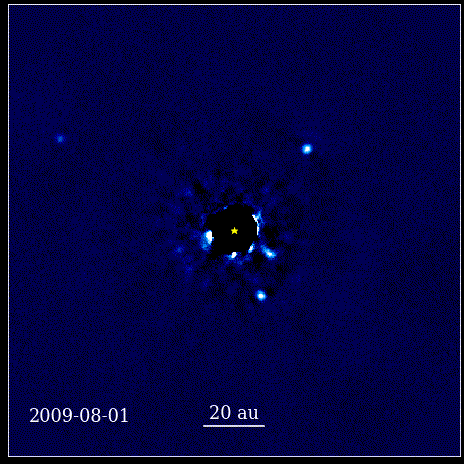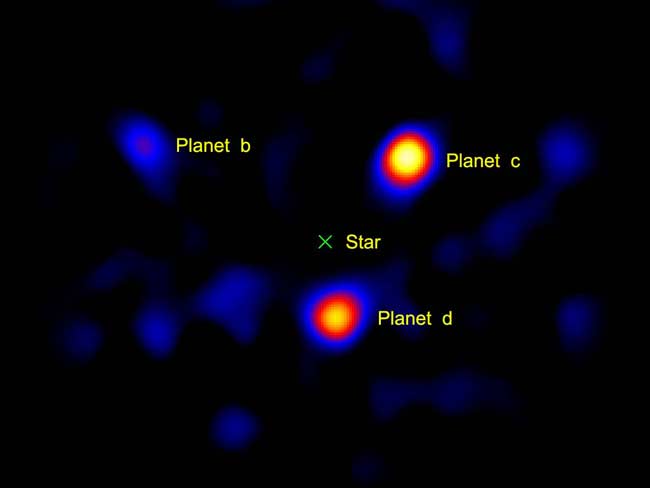Exoplanets dance around distant star in stunning 12-year timelapse (video)
Each of these planets is bigger than Jupiter and takes dozens of years to orbit the parent star.
Four Jupiter-mass exoplanets dance around their parent star in a stunning new timelapse collected over a dozen years.
The aim of the newly released video is to make the long orbits of these massive exoplanets more recognizable to a wide audience, Northwestern University astrophysicist Jason Wang said in a statement.
"This video shows planets moving on a human time scale. I hope it enables people to enjoy something wondrous," said Wang. In real life, the planet nearest the star HR8799 takes 45 years to make a single circuit. The world farthest away would take half a millennium (500 years) to go around the star once.
Related: 9 alien planet discoveries that were out of this world in 2022

HR8799 is 1.5 times more massive than our sun and lies roughly 133 light-years from Earth in the constellation Pegasus. (By comparison, the closest star system to us, Alpha Centauri, is a bit more than 4 light-years away.)
While a bit more massive than our sun, HR8799 is much more luminous: it has five times the intrinsic brightness of Earth's start. HR8799 is also very young at just 30 million years, compared with our midlife sun, which is 4.5 billion years old.

HR8799 was the first star system ever to have its planets directly imaged, which was accomplished and announced in November 2008. The new timelapse uses footage from the W. M. Keck Observatory atop Maunakea in Hawaii.
Get the Space.com Newsletter
Breaking space news, the latest updates on rocket launches, skywatching events and more!
Keck has great advantages for astronomy: adaptive optics to compensate for the blurring effects of Earth's atmosphere, and a coronagraph that blocks the light from the parent star, allowing the reflected-light "fireflies" (planets) to shine through.
Wang and his colleagues created one timelapse after using seven years of periodic observations. The newly released timelapse is an updated version, with 12 years of observations from when Wang's team had access to the telescope.
"There’s nothing to be gained scientifically from watching the orbiting systems in a timelapse video, but it helps others appreciate what we’re studying," Wang said. "It can be difficult to explain the nuances of science with words. But showing science in action helps others understand its importance."
Elizabeth Howell is the co-author of "Why Am I Taller?" (ECW Press, 2022; with Canadian astronaut Dave Williams), a book about space medicine. Follow her on Twitter @howellspace. Follow us on Twitter @Spacedotcom or Facebook.
Join our Space Forums to keep talking space on the latest missions, night sky and more! And if you have a news tip, correction or comment, let us know at: community@space.com.

Elizabeth Howell (she/her), Ph.D., was a staff writer in the spaceflight channel between 2022 and 2024 specializing in Canadian space news. She was contributing writer for Space.com for 10 years from 2012 to 2024. Elizabeth's reporting includes multiple exclusives with the White House, leading world coverage about a lost-and-found space tomato on the International Space Station, witnessing five human spaceflight launches on two continents, flying parabolic, working inside a spacesuit, and participating in a simulated Mars mission. Her latest book, "Why Am I Taller?" (ECW Press, 2022) is co-written with astronaut Dave Williams.
-
rod HR8799 is a well-studied and documented system over the years. Here are some past examples.Reply
Exoplanet Atmospheres Reveal 'Peculiar' Fingerprints, http://www.livescience.com/28851-exoplanet-atmospheres-reveal-peculiar-fingerprints.html
GRAVITY instrument breaks new ground in exoplanet imaging, https://phys.org/news/2019-03-gravity-instrument-ground-exoplanet-imaging.html -
rod The Extrasolar Planets Encyclopaedia (exoplanet.eu), this site shows masses ranging for HR 8799 exoplanets, 7 Jupiter to 9.6 Jupiter with semi-major axes ranging 16.4 to 68 au from the star.Reply
NASA Exoplanet Archive (caltech.edu), this site is similar. Mass range 7 to 10 Jupiter masses, sem-major axes 14.5 to 70 au. Host star mass 1.5 to 1.61 solar masses. -
Helio Reply
Interesting.rod said:GRAVITY instrument breaks new ground in exoplanet imaging, https://phys.org/news/2019-03-gravity-instrument-ground-exoplanet-imaging.html
They, apparently, were able to get 10x better resolution of the system's spectrum. Then they tickled-out the planet's contribution to isolate its spectrum, I assume. I believe this would require it to be a transiting planet. -
rod I went back and reviewed the exoplanet.eu site and NASA archive site for stars with multiple planets.Reply
exoplanet.eu site shows 853, the NASA archive site shows 880, both include HR 8799 system (4 planets). Both sites show stars with 4 or more, up to 8 (107 systems). This includes TRAPPIST-1 system. Comparing these multi-planet systems is very interesting when looking at our solar system. HR 8799 is a good example. Another interesting example, Kepler-11 system with 6.









